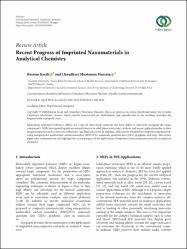| dc.contributor.author | Keçili, Rüstem | |
| dc.contributor.author | Hussain, Chaudhery Mustansar | |
| dc.date.accessioned | 2019-10-23T17:56:23Z | |
| dc.date.available | 2019-10-23T17:56:23Z | |
| dc.date.issued | 2018 | |
| dc.identifier.issn | 1687-8760 | |
| dc.identifier.issn | 1687-8779 | |
| dc.identifier.uri | https://dx.doi.org/10.1155/2018/8503853 | |
| dc.identifier.uri | https://hdl.handle.net/11421/22934 | |
| dc.description | WOS: 000438903800001 | en_US |
| dc.description | PubMed ID: 30057612 | en_US |
| dc.description.abstract | Molecularly imprinted polymers (MIPs) are a type of tailor-made materials that have ability to selectively recognize the target compound/s. MIPs have gained significant research interest in solid-phase extraction, catalysis, and sensor applications due to their unique properties such as low cost, robustness, and high selectivity. In addition, MIPs can be prepared as composite nanomaterials using nanoparticles, multiwalled carbon nanotubes (MWCNTs), nanorods, quantum dots (QDs), graphene, and clays. This review paper aims to demonstrate and highlight the recent progress of the applications of imprinted nanocomposite materials in analytical chemistry. | en_US |
| dc.language.iso | eng | en_US |
| dc.publisher | Hindawi LTD | en_US |
| dc.relation.isversionof | 10.1155/2018/8503853 | en_US |
| dc.rights | info:eu-repo/semantics/openAccess | en_US |
| dc.title | Recent Progress of Imprinted Nanomaterials in Analytical Chemistry | en_US |
| dc.type | review | en_US |
| dc.relation.journal | International Journal of Analytical Chemistry | en_US |
| dc.contributor.department | Anadolu Üniversitesi, Yunus Emre Sağlık Hizmetleri Meslek Yüksekokulu, Tıbbi Hizmetler ve Teknikler Bölümü | en_US |
| dc.relation.publicationcategory | Diğer | en_US] |
| dc.contributor.institutionauthor | Keçili, Rüstem | |


















